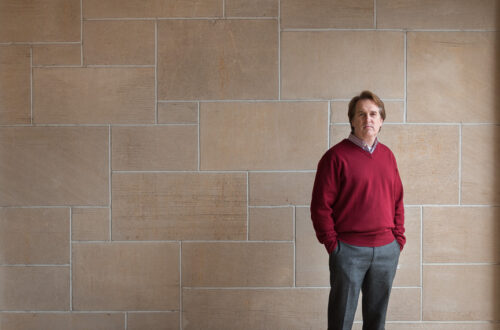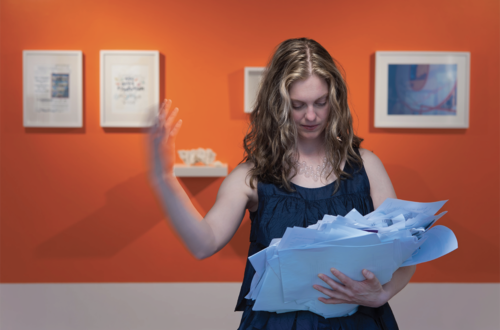
showing/thinking: Bridget Roosa
Bridget Roosa is a professor of dance and chair of theatre and dance at Agnes Scott College. She holds a B.F.A. from Southern Methodist University and her M.F.A. from Florida State University. Her teaching and scholarly interests include ballet and modern technique, choreography, labanotation and dance history. Labanotation is a form of documenting dance using abstract symbols to describe what the body does to perform movement, used for the preservation of dance. Below are Professor Roosa’s reflections on her love of dance and academic process, from the 2017 Dalton Gallery exhibition showing|thinking, a series of exhibitions that highlighted the work of faculty and staff on campus:
I have always found most comfort communicating through my body. Movement is a natural reflex that we practice before we are even born. Using movement as my preferred means of communication has been invigorating to my work as a dance artist, and I have utilized my artistic voice through my stagings from Labanotation score, choreography and personal performances. These cathartic experiences have taught me much about myself and my role in society and how communication through the instrument of the body can encourage change on a community level.
Through choreography, I choose to create work that has meaning beyond the movement so that the choreography is driven by an idea that the dancers can grasp and connect with. In my experience, when the dancer can emotionally connect to the work, the commitment to the piece is stronger, making the artistry speak to the audience. I also find that my movement vocabulary is challenged and inspired by this focus, allowing me to create a movement score individual to each work even as the body is limited to its physical capacities. When required, I utilize props to further convey a message or intent. This way of working is directly connected to liberal learning, as the dance is affected by other disciplines involved in a particular idea. Readings, videos and discussions regarding the intention of the work are just as important as having the work rehearsed and performed. Recently I have created original works of choreography with topics ranging from eating disorders, social injustices, Parkinson’s disease, the deadly tsunami in 2004, etc.
My Labanotation training began at Southern Methodist University where I was an undergraduate dance major and required to take Elementary Labanotation. I also had the invaluable experience of dancing in Helen Tamiris’ How Long, Brethren? staged from Labanotation score. This life changing exposure early on led me to realize there was much more than the notated score that completed the reconstruction/staging process. Cast members were immersed into readings and discussions to further our understanding of the historical implications that drove the creation of How Long Brethren? This process proved that reconstruction was more than just executing movement correctly and technically. It became a dance about the people with emotions that, as dancers, we were portraying. This approach, which combines repertory with history, affected me immensely. This experience shaped the way I proceed in staging work from score and caused me to further pursue scholarship in Labanotation.
Staging work from Labanotation score is an act in preserving the history and legacy of the dance discipline. While written documentation in the form of texts, sparse photographs, and video footage exist, there is nothing that can compare to a live performance of a piece of choreography. A Labanotation score allows for choreography to be brought back into the performance venue and out of a text book. Labanotation is a symbol-based language used to analyze, describe, and document movement. For over 70 years, the Dance Notation Bureau (DNB) has committed itself specifically to the preservation of dance. Labanotation scores,
in the form of manuscripts, preserve not only the choreographic work but vital directorial and production information as well. Just as a professional musician wouldn’t choose to learn a piece of music from a recording, a Labanotation scholar wouldn’t choose to pass on a dance from video if given the choice. My belief in the theory allows me to understand that the Labanotation score is a resource that contains exact movement information for each body part, in specific time, and with description of energy and spatial orientation. This highly descriptive and accurate document holds the key information about the style, nuance, dynamic quality and intent of a choreographer’s work that a video and/or written text couldn’t tell as honestly and purely.
I have been staging from Labanotation score for many years, passing on dance tradition and educating students and audiences of the value and historical importance of the dance discipline. There are many factors involved in my choosing a piece of choreography to stage from Labanotation score. More recently I find myself asking the following questions: Does current society need to be reminded of the necessity of humanity and/or its cultural importance? Is there a particular piece of choreography from the past that connects with similar political movements today?
Once I have chosen a piece of choreography for staging, my research process begins. This is when texts, photos, video footage and reviews become a necessary resource used to enrich the movement description of the Labanotation score. As the stager, I understand that it is my responsibility to convey the intent of the original choreographer. It is this gathered information that assists in the process of the movement becoming a part of my skin, almost as if I created it myself. This seamless connection with the work is vital in translating the movement from the paper to the bodies of the dancers. Each work I present from Labanotation score is held to this high level of accuracy and authenticity. As I go though the DNB Notated Theatrical Dances Catalog, I search for a piece of choreography that will be challenging both technically and artistically as well as connect the past with the present. Through the artistic voice of some of our founding modern dance pioneers, I have staged works of activism and cultural representations that have had a focus on lynchings, oppression of the African American Community, The Shaker Sect, The Holocaust, and many other subjects that were given a voice through movement.
Throughout all of my work with Labanotation and choreography, my philosophy has come to revolve around the notion that appreciating the history and evolution of this art form enhances the dancer’s awareness of movement intention, therefore engaging the dancer more intellectually. This intellectual connection will continue to expand their performance artistry and technique, assisting the young dancer in the development of their teaching and performing careers. Therefore, the staging process should be taken very seriously and I find it is a great responsibility to represent a choreographer’s work genuinely, especially when they are no longer around to direct it themselves.
Whether through the tool of a Labanotation score or creating my own work, communicating through the body will always be the method of choice and I will continue to uphold my standard of presenting authentic, accurate performances throughout my career. I find myself to be an ambassador of the form of dance documentation through my continued work and it never ceases to amaze me how excited the students get about dancing a piece they have read about in the history books and how audiences are connecting choreography of the past to the present. As an artist I will continue to uphold the traditional aspects of the art form that have fueled the present and will continue to shape the future.




